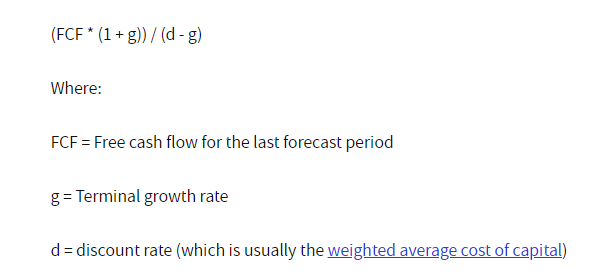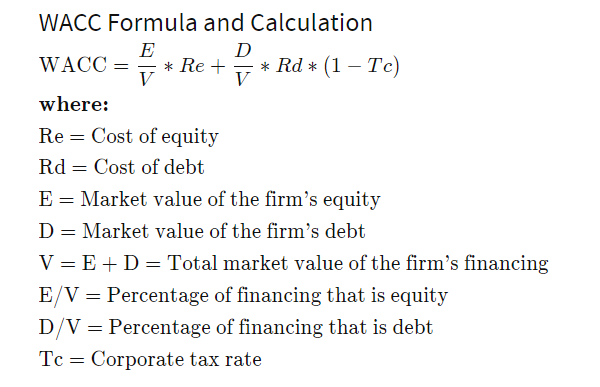Cash flow cannot be same in both the cases. Cash flow in the first case will be higher by the rent saved throughout the life of the asset. Terminal Value will also be higher, which you don’t seem to have considered. You can look up Prof. Aswath Damodaran’s blog or book or YouTube videos for conceptual clarity on this subject.
Thanks once again. Yeah ideally business 1 should have more cash flow.
I recently started following Aswath Damodaran. Will listen to his valuation lecture series. I am using below formula for terminal value.

And WACC. Looks like I need to work on the Cost of equity.

Dear all,
According to the last quarter data, promoters own 93 % in Wabco industries, which was 75% in the last quarter. Mutual fund holdings which was around 8% earlier has now become 0.1%. Could this be a step to help them in the process of delisting? What could be the implications of this? Should they not comply with the rule that promoters shall not have more than 75% holding? @dineshssairam, sir any views on this? TIA
Hello can you give me idea about reserves in the balance sheet. Is it in the form of cash?
Reserves are liabilities of a company towards it’s shareholders.
Since liabilities should match with assets on a balance sheet, there needs to be corresponding entries in Assets. However, it need not necessarily be Cash alone. Sure, a part of it can be cash, but not necessary.
I have two questions gurus.
- Everyone keeps saying that to read at least last 5 (10 years if you can)years of annual report to get some idea about company how it has travelled.
I find it cumbersome reading annual report in digital form pdfs.
Just trying to understand, how others go on this. Do you guys always print and read or just digital form.
- I am still trying to learn balance sheet, Profit and loss statement and free cash flow.
I am thinking to buy some academic books about accounting and read it for 2 years. I have found few books in the below link.
is it worth doing it ? or just learn basics of balance sheet, p&l, free cash flow and then start reading annual report and industries and then start investing in stocks.
Peter lynch says in the book called learn to earn, to learn about accounting by taking some course.
I have already completed few online courses in Swayam which is provided by IIM Bangalore.
Regards,
Mani
One of the mistakes most people make, or at least I made when I started was spending too much time on reading how to analyze, instead of doing the actual analysis itself. So once you have basic knowledge of what equity is, what things like receivables, inventories, payables are, what goes into P&L, etc. just jump into analyzing annual reports. It’s like reading about how to swim vs actually jumping into the water and practicing. You know which one would be more effective ![]()
I think a better approach would be to spend 90% of your analysis time on actual financial statements and the remaining 10% on reading about how these things work. YouTube is another good resource ![]() how to analyze.
how to analyze.
A faster way to run through annual reports is to use data from websites like screener.in and read 3-4
pages like director’s report and management discussion and analysis from the annual report. If some numbers are not making sense on screener, refer the notes to accounts in the annual report. I find this more effective than reading the full report with several time consuming pages with gibberish like regulatory compliance, shareholding structure, etc. The latter part is available on screener anyway. So why waste hours when you can spend minutes on screener and get the job done? Refer the AR only when something seems out of the line or fishy.
@vkp reserves are retained earnings of a company that are carried over from the p&l from the previous year to the balance sheet this year.
Suppose you start a small co. with 100 bucks, and you make 20 bucks of profit after tax. Out of this 20, you pay 10 bucks as dividend to the shareholders, which is yourself. Now the remaining 10 bucks get carried over to next year’s balance sheet as reserves.
Year 1
Share capital 100
Reserves 0
Total equity 100
Profit 20
Dividend 10
Retained earnings 10
Year 2
Share capital 100
Reserves 10 (carried over from last year’s retained earnings)
Total equity 110
Hello people, I wanted to get some advise on how do you analyze a company which does not conduct con-calls, as the information available is quite less?
except reading ValuePickr thread what are some other ways to analyze such a company?
So the company can use its reserves to debt payment or capex ?
@arjunbadola One can rely on credit rating reports or do scuttlebutt with employees, distributors, attend AGM etc.
Another way is to search for hashtag company name on Twitter eg #alembicpharma and see what others have written about the co.
Yet another way is to get on concalls of listed competitors of the co. ask them why so and so number is different than your competitor
Reserves are a notional number and exist only in our mental calculations.
Reserves are primarily used to calculate how much equity a co. has and to in turn calculate efficiency ratios like ROCE, ROE, etc.
To repay debt, the co. needs cash, which comes from CFO / CFI / CFF in the cash flow statement
These are some good ideas thanks! Also, I wanted to know can a non-shareholder + retail investor join a con-call and ask questions?
You are welcome 
I believe you can attend concalls without being a shareholder.
However, to attend a co’s AGM you need to be a shareholder, in which case, you can buy just 1 share and attend the AGM.
You can always sell that 1 share after attending the AGM, just in case you don’t like anything the management says during the AGM.
So what’s the use of the reserves?
To measure efficiency of the co. via ROCE / ROE etc.
Another use of reserves is to issue bonus shares, etc.
These are accounting concepts which one can grasp only by manually crunching numbers and getting their hands dirty with data 
Reserves are an accounting “residual”. In theory, a business starts out with share capital and debt. When profits are reported, a part of profits are paid out as dividends. What is retained accumulates as Reserves. Once in a while, Reserves get incremented when fresh equity is issued at a premium to face value and reduced if bonus shares are issued.
You cannot “see” reserves. They don’t exist in the form of cash in a locker or a bank deposit, or even as plant & machinery. From a financial analysis perspective, it is preferable to consider the Equity & Reserves together (Net Worth) and not separate from each other.
Lets say a company makes 100 Rs profit and gives out 70 Rs as dividends. The remaining 30 Rs is retained in reserves. When you say they dont exist in the form of cash, then where does this 30 Rs go?
Can the company use this 30 Rs to fund future expansion?
